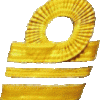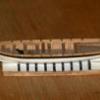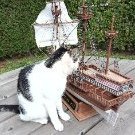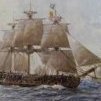MORE HANDBOOKS ARE ON THEIR WAY! We will let you know when they get here.
×
-
Posts
1,553 -
Joined
-
Last visited
Reputation Activity
-
 G.L. reacted to michael mott in Skipjack by michael mott - 1/8th scale - SMALL - 19 foot open launch
G.L. reacted to michael mott in Skipjack by michael mott - 1/8th scale - SMALL - 19 foot open launch
Thanks for support and comments.
I did some tests today for the ribs (frames). When we lived at the lake we cut some and purchased some Birch firewood A couple of the larger split logs were really clean and straight grained so I split them up a little more and prepared some 1/4 cut billets that were approx 1 inch x 2 inch x 12 inches long They have been drying for about 5 years now so today I cut one up into 1 1/2" x 1/2" scale ribs (3/16 x 1/16 actual)
I had done some bending tests with other woods as well, left to right Birch, Yellow Cedar, Castello, Maple, and Beech. The air dried Birch bent the best.
So a couple of test bends on the form to see how they are overnight. I wrapped the frame in a wet paper towel and popped it into the microwave for 1 minute then used the hot air soldering station to add a little more heat as I bent the frame in the bending jig before pinning it to the form.
These are just some preliminary tests.
Michael
-
 G.L. reacted to LyleK1 in Sea of Galilee Boat by LyleK1 - FINISHED - SE Miller - 1/20 scale
G.L. reacted to LyleK1 in Sea of Galilee Boat by LyleK1 - FINISHED - SE Miller - 1/20 scale
The first two planks on each side are full sized planks (width). The first fits into the notches cut into each form. I had to modify the form closest to the stern to accept the plank at the right angle. The stern end needed to be sanded to the proper angle to meet the sternpost. Once achieved it was glued into place using a medium thick CA (I'm using that for all the plank ends, per the instructions). The remaining plank is fitted into the notches, cut at the bow and sanded slightly to match the bow piece.
The first plank:
The second plank was done the exact same way:
I tried various clamps to get the fit as perfect as possible, using some to keep the "clinker" effect to a minimum and the others to hold the seams between planks nice and tight. Once everything is fitted, I used a thin CA to "weld" the joints between the planks being as careful as possible not to get any of the glue on the forms... not sure how successful I was and I'm sure I'll find out later!
The next several planks are tapered and I received the kit with the tapering already done.
The process to prepare a plank is as follows.
I heated and bent the plank just to help ensure they don't break.
Some light sanding and forming at both ends:
And then gluing into place just like the first two planks.
Clamps hold the planks against the forms and against each other. At the stern, the previously mentioned (and shown) post comes into play to keep the clamps from sliding off:
And at the bow, I've modified a clamp by gluing sandpaper to the clamp surfaces to keep it from sliding off:
It works really good!
Clamps are installed:
And thin CA to "weld the joints:
I've completed five planks on each side, alternating as I go to keep thing from getting out of whack.
Here is where I stopped for today:
One or two more planks and I'll be to the curve in the hull and things will get a bit tougher but nothing like working with walnut as is being used on the Bounty in the background!!
More in a few days.
-
 G.L. reacted to LyleK1 in Sea of Galilee Boat by LyleK1 - FINISHED - SE Miller - 1/20 scale
G.L. reacted to LyleK1 in Sea of Galilee Boat by LyleK1 - FINISHED - SE Miller - 1/20 scale
I've made some decent progress!
The first steps were to build the strongback. Straightforward and pretty simple:
The board came pre-marked with a centerline and locations for each of the forms. The post at the stern is not part of the boat but comes in real handy later
I glued the marked form pieces together. Again, very easy and straightforward:
The only real issues was making sure the pieces were flush at the base. I used regular wood glue for this portion of the job to ensure I had the ability to adjust the pieces, if needed.
Next, I glued the forms down on the board per the instructions:
I used the thick CA glue for this process. The center two forms were not perpendicular and I added a brace to fix that problem.
The keel and stern post came pre-assembled. I still had to shorten the post a bout 1/4" and heat and bend the keel section near the stern as it was not curved correctly... an easy fix. Once satisfied I glued it down per the instructions:
The sternpost is glued to the board and the scrap blocks are glued to the post and the board. When it is time to remove the boat from the strongback, I'll simply cut the post even with the blocks (per the instructions).
I used a few nails to ensure the keel ran straight over the centerlines of the forms.
And then added the bow section using the same method as the stern:
So far, so good!
Next I'll be laying the first planks.
-
 G.L. got a reaction from Old Collingwood in La Belle Poule 1765 by mtaylor - Scale 1:64 - POB - French Frigate from ANCRE plans
G.L. got a reaction from Old Collingwood in La Belle Poule 1765 by mtaylor - Scale 1:64 - POB - French Frigate from ANCRE plans
I think wood carving like Mark does is more authentic and closer to contemporary models.
-
 G.L. got a reaction from GrandpaPhil in Clipper d'Argenteuil by G.L. - scale 1/15 - POF - SMALL
G.L. got a reaction from GrandpaPhil in Clipper d'Argenteuil by G.L. - scale 1/15 - POF - SMALL
I'm afraid it is getting a bit monotonous, but also this week I can show nothing but pictures of the planks. From now on I alternately place a plank at the top and one at the bottom.
I hope to close the gap in my next post.
Thank you very much for reading this log, for your likes and for all your interesting reactions.
Till next week!
-
 G.L. got a reaction from FriedClams in Clipper d'Argenteuil by G.L. - scale 1/15 - POF - SMALL
G.L. got a reaction from FriedClams in Clipper d'Argenteuil by G.L. - scale 1/15 - POF - SMALL
I'm afraid it is getting a bit monotonous, but also this week I can show nothing but pictures of the planks. From now on I alternately place a plank at the top and one at the bottom.
I hope to close the gap in my next post.
Thank you very much for reading this log, for your likes and for all your interesting reactions.
Till next week!
-
 G.L. reacted to tlevine in Swallow 1779 by tlevine - FINISHED - 1:48 scale
G.L. reacted to tlevine in Swallow 1779 by tlevine - FINISHED - 1:48 scale
Time for some modeling surgery. In order to position the bowsprit in the midline, the step needs to be moved. The holes were already made in the deck for the step. One of the holes will be hidden by the center part of the step but the port side one needed to be repaired. My options were: remove and replace the two deck planks where the hole passed or make a plug and insert it in the hole. My concern was that I would probably do more damage to the surrounding planks and waterway by doing so. Look at the June 5th post to see that these were not typical planks. I opted for a plug. The repair is not perfect, but I believe this was the more prudent approach.
Next, the stem head was installed. This has a shallow mortise at its foot into the stem. A small scroll is carved at the fore end.
-
 G.L. reacted to michael mott in Skipjack by michael mott - 1/8th scale - SMALL - 19 foot open launch
G.L. reacted to michael mott in Skipjack by michael mott - 1/8th scale - SMALL - 19 foot open launch
Had a chance in between a few other commitments to get the new clamps made and mounted, I also remade the location strip in order to align the clamps, and so did up a new print while I was at it.
Now I can finish the rabbet and get on with the frames and floors.
Michael
-
 G.L. got a reaction from yvesvidal in Clipper d'Argenteuil by G.L. - scale 1/15 - POF - SMALL
G.L. got a reaction from yvesvidal in Clipper d'Argenteuil by G.L. - scale 1/15 - POF - SMALL
I'm afraid it is getting a bit monotonous, but also this week I can show nothing but pictures of the planks. From now on I alternately place a plank at the top and one at the bottom.
I hope to close the gap in my next post.
Thank you very much for reading this log, for your likes and for all your interesting reactions.
Till next week!
-
 G.L. got a reaction from Baker in Clipper d'Argenteuil by G.L. - scale 1/15 - POF - SMALL
G.L. got a reaction from Baker in Clipper d'Argenteuil by G.L. - scale 1/15 - POF - SMALL
I'm afraid it is getting a bit monotonous, but also this week I can show nothing but pictures of the planks. From now on I alternately place a plank at the top and one at the bottom.
I hope to close the gap in my next post.
Thank you very much for reading this log, for your likes and for all your interesting reactions.
Till next week!
-
 G.L. reacted to turangi in Emma C Berry by Turangi - Model Shipways - 1:32
G.L. reacted to turangi in Emma C Berry by Turangi - Model Shipways - 1:32
I forged ahead at my usual breakneck speed😉. I fabricated and installed the fittings on the bow, quite straightforward with some file work and bending. I next turned my attention to marking, masking and painting the waterline area using hopefully fairly accurate measurements from the plans. I cobbled together a marking apparatus, then masked the area with 6mm Tamyia tape and dashed on some paint. I am satisfied with the result. I dragged my feet on doing this as it had disaster written all over it in my mind. Went well I think. One side down and hopefully the other tomorrow.
-
 G.L. reacted to VTHokiEE in 18th-Century Merchantman Half-Hull Planking Kit by VTHokiEE - FINISHED - NRG - 1:48
G.L. reacted to VTHokiEE in 18th-Century Merchantman Half-Hull Planking Kit by VTHokiEE - FINISHED - NRG - 1:48
I decided to try to revive this log (I had originally decided that I was simply going to upload finish pictures) as I needed something to distract myself with lately. I just started putting the wale on so here is where I stand. I've learned a lot on this kit so far and I feel like I'm improving with every step. That being said not all planks are quite as tight as I wish they were and some of the runs have waves that I would work hard to avoid in the future. As a learning guide I decided to continue instead of starting over so please excuse my work ha!
I’ll note that I deviated from the instructions for the wale. I decided to rip planks of the proper width for wale and install them instead of making the point measurements. I tried the method in the instructions but when I looked at the plank it was no good. I used the top line of the wale that I drew earlier to guide the planks.
-
 G.L. reacted to Chuck in HMS Winchelsea - FINISHED - 1764 - by Chuck (1/4" scale)
G.L. reacted to Chuck in HMS Winchelsea - FINISHED - 1764 - by Chuck (1/4" scale)
Two winnie's....
I know these pics arent that good but it was tough to take pictures at the time. Mike's Winnie next to mine again ....
Most notable to mention...One is made entirely of Boxwood while the other is made almost entirely of Yellow cedar. Can you tell the difference? Yellow Cedar at a third the cost of Boxwood, LOL.
It was such a nice afternoon.
And a quick look at what I am designing for the catheads. I am working on the design for parts we will need much later in the project. I am making some beta tests. Here is the cathead under development. I think this is the final iteration I will go with. Laser etched side panels and star carving. Actual working sheaves as well. Its a little too short and I just have to lengthen it about 3/32". Then its good to go. Each piece of this project was probably tested and remade about 5 or 6 times before you get the final parts.
-
 G.L. reacted to giampieroricci in HMS PEGASUS by giampieroricci - Scale 1:36 - Swan-Class Sloop from plans by David Antscherl & Greg Herbert
G.L. reacted to giampieroricci in HMS PEGASUS by giampieroricci - Scale 1:36 - Swan-Class Sloop from plans by David Antscherl & Greg Herbert
The hawse pieces:
Of course, everything still needs to be roughed out. I kept myself very abundant!
-
 G.L. reacted to bobandlucy in Muscongus Bay Lobster Smack by bobandlucy - FINISHED - Model Shipways - Scale 1:24
G.L. reacted to bobandlucy in Muscongus Bay Lobster Smack by bobandlucy - FINISHED - Model Shipways - Scale 1:24
Glued in the coaming and cabin sides. I did not pre-paint them as I will be priming and painting the deck due to all the fill used. I'm thinking some light buff or cream paint that might resemble wood, if I can find it. Any ideas?
First pic shows a difference between the prototype and this model. The operating rod for the centerboard is shown in the kit manual as resting in the down position all the way to the end of the slot towards the stern, so that it rests between the two wet well covers. In my opinion, this would be the most attractive position for display. As you can see, in my model the rod movement is stopped by the bulkhead below the deck. I guess this is my error, I should have notched the bulkhead earlier on. It will be tricky to correct now, but I may give it a shot. . .
-
 G.L. reacted to tlevine in NRG Capstan Project
G.L. reacted to tlevine in NRG Capstan Project
All that is left to make is the capstan bars and brakes. This was shown in the intermediate version and will not be repeated.
Time to put everything together. This was a fun project to design and build. It does not take a long time to build and it makes a handsome desk ornament without the bars or in a display case with the bars installed. The project is available for purchase in the NRG store at https://thenrgstore.org/collections/plans-and-projects/products/capstan-project. It contains separate plans and monographs for the intermediate and advanced versions.
-
 G.L. reacted to tlevine in NRG Capstan Project
G.L. reacted to tlevine in NRG Capstan Project
An alternate approach would be to use brass instead of wood to represent the iron ring. The bolts are brass nails with their heads filed flat. The holes for the capstan bar pins have been drilled.
After a coat of finish, the capstan is trial fit on the step. Compare the appearance of the step and capstan in the next two pictures, showing the effect of a coat of Watco's. I used copper wire for the whelp bolts and they have not been blackened yet. This will be done with liver of sulfur.
The eyebolts and capstan bar pins have been installed. Make sure the chain is long enough to allow removal of the pin.
-
 G.L. reacted to Chuck in HMS Winchelsea - FINISHED - 1764 - by Chuck (1/4" scale)
G.L. reacted to Chuck in HMS Winchelsea - FINISHED - 1764 - by Chuck (1/4" scale)
Thanks Mike....Tomorrow I have to remember to take pictures of both our Winnie models next to each other. It will be interesting to see both together now that we are so much farther along. Way back when we managed to take a picture at this stage....we have come a long way since then.
It will be really fun to get the guys together after 18 months....I am looking forward to it. We have about a guys from our club coming by the shop for some lunch and they will be bringing their models that they have been working on during the lock-down!!! Good times!!!
-
 G.L. reacted to Chuck in HMS Winchelsea - FINISHED - 1764 - by Chuck (1/4" scale)
G.L. reacted to Chuck in HMS Winchelsea - FINISHED - 1764 - by Chuck (1/4" scale)
There are two rails/fore bitts forward and aft of the foremast on the Fcastle. These are interesting fittings in that they extend from the gundeck through and up to the f'castle. So we will start chapter 8 with those. But first a little prep work.
I knew when I drafted the plans for Winnie ....specifically the deck clamps...that at the extreme bow I would probably incorrectly space the notches for the deck beams. This turned out to be true. It was difficult for me to design the deck clamps as the rounded the bow so the beams of the f'castle would be properly spaced and positioned. I knew I would be adjusting them before I started making the fittings below the f'castle beams.
Turns out that only forward six deck beam notches need to be altered. They need to be moved forward a bit in ever increasing distances as the get closer to the bow. This is very easy to do as you guys only have to widen your notches for those six forward deck beams. So place all the beams temporarily in their current notches and use the supplied template to see how far forward all of those six beams should be moved. The last or forward most beam has to be moved 5/32" forward and requires the most extreme shift to the notch in the deck clamp.
Here is a photo of the template in position after all the forward deck beams were moved.
You will be referring back to this template often as you work.
With that completed lets build the bowsprit step and two rails. But remember that these are all one piece on the actual ship BUT split in half between decks on our model to simplify matters. Even though you will be building the actual rails now for the f'castle they wont be needed until a much later chapter. Its just easier to build them together so they are the same width when completed. This will help the illusion that they are all one piece later on. There is the bowsprit step made from 4 laser cut pieces.....which has a rail above it. There is a "Y" shaped element on the aft side of the foremast which also has a rail above it and was one continuous piece. Or at least they should look that way when done.
So build these from the laser cut boxwood pieces.
Note the square hole for the aft end of the bowsprit tenon. That was actually a mistake from my original design. The bowsprit angle was changed during construction as noted on the original draft/plans to a steeper angle. This hole was actually below deck and wouldnt be seen so I removed it and made another which you will see.
Note how the rails are the same width as the parts below deck and thus its easier to build these together even though we wont be mounting the rails above the deck beams yet. But this is what it will look like and what we are shooting for if it was mounted. We are starting with the fourth deck beam from the stem.
The rail is just temporarily in position to show you guys how it should look.
But we are basically adding the fourth beam first.....
Then positioning the bowsrit step. This has a slight angle as shown on the plans. Then I added the two manger barriers on either side of the bowsprit step.
The manger barriers are basically a wooden partition on either side of the bowsprit step. They are laser cut for you. First glue the two flat boards together edgewise to form the barrier. shown on top below.
Then take that barrier and position it on the model. Both ends need to be shaped to fit you bulwarks and beveled to fit against the bowsprit step. Each partition will be slightly longer so you can take your time and care to get the correct shapes.
Once they fit....add the strops on each end....
1/8" x 1/64" strips to simulate the slotted fixture these two boards would be slid into. These partitions were always being removed and repositioned to give access to the manger area.
As you can see I painted mine red.
This is what it looks like all done without the rails above the bowsprit.
Note that I also added the hanging knees on each side of the fourth deck beam. It was just easier to add them know. When positioning the manger partitions....CAUTION....
Beware that the position along the bulwarks is important. You will need to keep it clear of where other hanging knees will fall and the scupper should you choose to show them.
From this point I added the remaining deck beams....knees and lodging knees moving forward towards the stem.
Just use the template and plan as a guide. Its no different then adding the knees for the qdeck. The only difference is that they are on the opposite side of the deck beams this time.
Next up I will add the cat tail for the catheads. It will be much easier to add them at this point before I start adding any more fittings and deck beams!!!
Any questions.???
Oh yes....I did make the riding bitts but they are just temp positioned. I still have to finish those and paint them. I should have removed them from the pictures before I took them.
-
 G.L. reacted to mtaylor in La Belle Poule 1765 by mtaylor - Scale 1:64 - POB - French Frigate from ANCRE plans
G.L. reacted to mtaylor in La Belle Poule 1765 by mtaylor - Scale 1:64 - POB - French Frigate from ANCRE plans
Michael,
I'm using a small bit of white glue to hold it in place on a piece of basswood. Soaking in alcohol removes the piece from the basswood when I'm done. Here's some photos of what I'm currently working on.... the birds and leaves and also the Arms of France. The blanks are 3/32" boxwood for these. The "little angel" was 1/8" as was the first one I did. The etching is done with a very low power pass at "high" speed so it's not very deep. I do etch extras as I'm a bit of klutz at times by either ruining the carving via a mistake or dropping it on the floor never to be seen again. As a side note, I may have to simplify the Arms of France even more than I already have, but we'll see.
Edit: Rats... I'll have to redo the Arms of France. Seems a cut a bit of the helmet plume. For now, I'll use this one a test to see what needs to be simplified.
-
 G.L. reacted to Gaetan Bordeleau in 74-gun ship by Gaetan Bordeleau - 1:24
G.L. reacted to Gaetan Bordeleau in 74-gun ship by Gaetan Bordeleau - 1:24
I recently hurt my leg so, I will not be working very much on the model for a while
I began this actual model in 2017 and I use Lightroom as a catalogue for the photos. Up to this day, over 3250 photos are classified in files. I have selected 12 photos representing my vision of this model through light variations in photography. After selecting these photos, it is clear that most of the photos were taken inside the model ship of a 74 guns at 1/24 scale. This model, is the fourth one of this series. Each model had different goals.
One goal, for this model is to try to photograph inside all the decks at the same time and if possible to have a good level of lighting at each deck. To get there, the deck planking is as far as possible: absent, so that more light can go through.
3 types of cameras were used: camera, action camera and phone camera. For the photos inside the model, the action camera works best and sometime, when I get lucky, the phone camera gives good results, but I rarely use the camera phone.
What would be the best advice I could give to an aspiring photographer? Light is always the first thing to check. there are also 2 other things that I always take great care:
First, I always photograph as close as possible to the same height of the object. By example, if I take a photo of the outside model, I will position the camera at the same height of the model or even lower sometimes. At the contrary, if I take a photo at a much higher position than the model, it will look like more like a toy.
Second, I always check so that the camera is parallel with the horizon. These simple 2 advices will get more realistic photos simply because it will be as if the photo was taken at the same height as the human eye. It is never interesting for the eye to see a model which is not parallel with the horizon.
-
 G.L. got a reaction from Tim Holt in Clipper d'Argenteuil by G.L. - scale 1/15 - POF - SMALL
G.L. got a reaction from Tim Holt in Clipper d'Argenteuil by G.L. - scale 1/15 - POF - SMALL
Chapter II. The hull
1. The building board
The drawings in the monograph give frame drawings every three frames. The frames will have to be laminated, so I will need a frame template for every frame, therefore I draw the missing frames by taking over the measurement from the line plan.
I use the frame drawings to saw out 29 frame templates in 3mm plywood. I make also a base and a backbone for the building board.
Base plate and backbone screwed together.
Starting to place the frame templates. The forward four are cant frames and have to be placed in pairs at an angle to the backbone.
All the others are perpendicular to the backbone.
The frame templates are placed in such a way between guide slats that they can easily be lifted out again. I check the horizontal and vertical angle while gluing the guide slats.
After a while all the templates are placed.
All frames have a different bevel, depending on the position at the front or rear. To smoothly sand the beveled edge of the templates, I start by coloring the edge of them with a red pencil.
The third after template is visibly wrong and has to be remade.
Sanding the templates. I use a kind of bow to do it, a flexible batten with a strip of sandpaper stapled on it. I sand until the pencil color has just disappeared
Portside is done:
when both sides are sanded, it becomes clear that the fifth frame from the front is also a bit too narrow. This one must also be remade.
Frame remade and sanded.
Now I can start to make the frames.
Thank you for reading this log, for your comments and likes.
Till next week!
-
 G.L. got a reaction from jansmiss in La Belle Poule 1765 by mtaylor - Scale 1:64 - POB - French Frigate from ANCRE plans
G.L. got a reaction from jansmiss in La Belle Poule 1765 by mtaylor - Scale 1:64 - POB - French Frigate from ANCRE plans
I think wood carving like Mark does is more authentic and closer to contemporary models.
-
 G.L. got a reaction from Canute in La Belle Poule 1765 by mtaylor - Scale 1:64 - POB - French Frigate from ANCRE plans
G.L. got a reaction from Canute in La Belle Poule 1765 by mtaylor - Scale 1:64 - POB - French Frigate from ANCRE plans
I think wood carving like Mark does is more authentic and closer to contemporary models.
-
 G.L. got a reaction from EJ_L in La Belle Poule 1765 by mtaylor - Scale 1:64 - POB - French Frigate from ANCRE plans
G.L. got a reaction from EJ_L in La Belle Poule 1765 by mtaylor - Scale 1:64 - POB - French Frigate from ANCRE plans
I think wood carving like Mark does is more authentic and closer to contemporary models.









